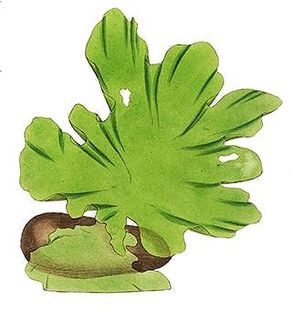
The sea lettuces comprise the genus Ulva, a group of edible green algae that is widely distributed along the coasts of the world's oceans. The type species within the genus Ulva is Ulva lactuca, lactuca being Latin for "lettuce". The genus also includes the species previously classified under the genus Enteromorpha, the former members of which are known under the common name green nori.
Arnoldiella is a genus of green algae in the family Pithophoraceae.
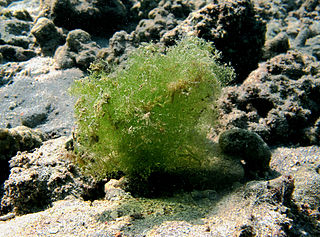
Boodlea is a genus of green algae in the family Boodleaceae.

Bornetella is a genus of green algae in the family Dasycladaceae.
Dangemannia is a genus of green algae in the family Oltmannsiellopsidaceae.
Derbesia is a genus of green algae in the family Derbesiaceae. The plant was originally known from different names applied to its larger sporophyte, Derbesia, and its less conspicuous gametophyte, Halicystis. Derbesia was successfully cultured in the laboratories of German phycologist Peter Kornmann to learn that both it and the plant Halicystis were different parts of the life cycle of the same organism.
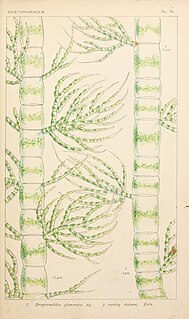
Draparnaldia is a genus of freshwater green algae in the family Chaetophoraceae. Draparnaldia are uniseriate; each filament is composed of a chain of cells arranged in one row. Chloroplasts appear as a band within the center of each cell. The length of the main axis cells are generally the same, regardless of whether or not they bear branches. These side branches are divided extensively into terminal hairs. The entire plant is enveloped in loose, slippery mucilage. Draparnaldia is a cosmopolitan genus with wide distribution and it is usually found in cold aerated waters. They are either attached to sand or grow epiphytically on other aquatic plants. Draparnaldia can be seen growing in clear streams trailing on stones and boulders. Herman S. Forest of The Southern Appalachian Botanical Club has stated that while not common, it is present frequently enough to be recorded in almost all local flora lists of green algae that have been compiled. A multitude of species are present in Lake Baikal, Siberia and have been described by Meyer and Jasnitzky. A species of the genus had been placed and described in the Linnean Herbarium as Conferva Mutabilis Roth in 1797. Nowadays Conferva is no longer used and the species is described as Draparnaldia mutabilis (Roth) Bory. Bory is added in honour of the researcher of the same name, based on whose description the genus was separated from similar appearing forms. Bory is accredited with the establishment of the genus.
Pabia is a genus of green algae in the order Trebouxiales.
Draparnaldiopsis is a genus of green algae in the family Chaetophoraceae.
Chlorokybus is a multicellular (sarcinoid) genus of basal green algae or charophyte, a soil alga. It has been classified as the sole member of the family Chlorokybaceae, which is the sole member of the order Chlorokybales, in turn the sole member of the class Chlorokybophyceae.

Calkinsia is a monotypic genus of excavates comprising the single species Calkinsia aureus. It lives in low-oxygen seafloor environments. It is not classified in any of the three well-known groups of the Euglenozoa, but is placed in its own group, the Symbiontida. Some authors have classified Calkinsia alongside Postgaardi, but Postgaardi has not been studied well enough to test this hypothesis.

Pierre Jean-Louis Dangeard was a French botanist. He was the son of botanist and mycologist Pierre Augustin Dangeard and brother of geologist and oceanographer, Louis Dangeard.

Cutleria is a genus of brown algae, one of 2–6 genera in the order Cutleriales. AlgaeBase recognises 11 species in the genus.
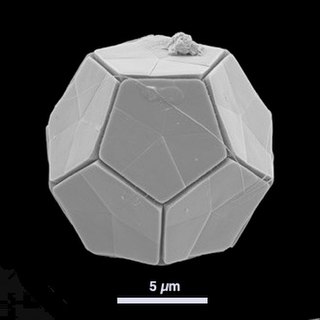
Braarudosphaera bigelowii is a coastal coccolithophore in the fossil record going back 100 million years. The family Braarudosphaeraceae are single-celled coastal phytoplanktonic algae with calcareous scales with five-fold symmetry, called pentaliths. With 12 sides, it has a regular dodecahedral structure, approximately 10 micrometers across.
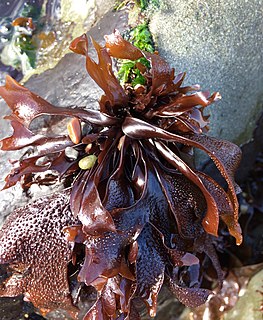
Mastocarpus papillatus, sometimes called Turkish washcloth, black tar spot, or grapestone is a species of red algae in the family Phyllophoraceae. It is sometimes confused with the distantly related Turkish towel which is of a similar texture but larger. The specific epithet papillatus is due to the nipple-like projections on the female gametophyte which can give the texture of a terrycloth washcloth found at a Turkish bath.
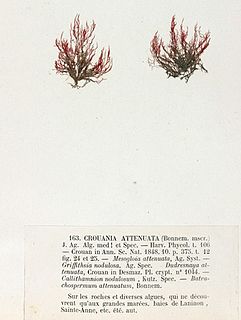
Crouania is a genus of red algae (Rhodophyta) in the Callithamniaceae family. The name of the genus honours the French born Crouan brothers, Pierre-Louis Crouan and Hippolyte-Marie Crouan. It was first described by Jacob Georg Agardh in 1842, and the type species is Crouania attenuata.
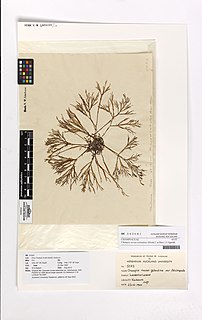
Champia is a genus of red algae in the family Champiaceae, first described in 1809 by Nicaise Auguste Desvaux
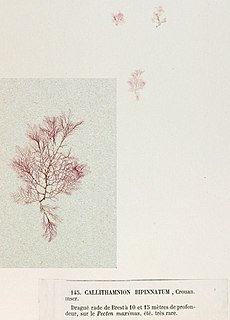
Aglaothamnion is a genus of algae belonging to the family Callithamniaceae.
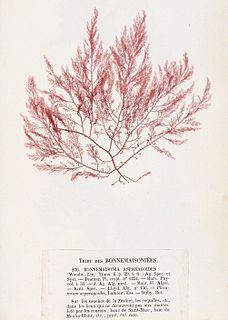
Bonnemaisonia is a genus of red algae belonging to the family Bonnemaisoniaceae.
Wislouchia is a genus of chlorophyte green algae. The name was first published in 2021, as a replacement name for Raciborskiella. As of February 2022, it was the only genus in the family Wislouchiaceae.












